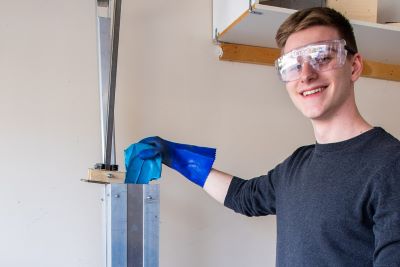Feds need to accelerate clean investment tax credits or risk losing billions in investment
Mark LoweyNovember 22, 2023
The federal government needs to move much faster in implementing a series of cleantech investment tax credits (ITCs) or risk losing billions of dollars of private investment to the United States, say leaders of Canada’s heavy industries.
Final investment decisions on Canadian cleantech projects worth billions of dollars are waiting on the ITCs, they told Research Money.
 “There’s a window right now where the investment community wants to invest and companies want to invest,” said Adam Auer (photo at right) president and CEO of the Cement Association of Canada. “We think Canada has a really good opportunity to attract its fair share, maybe even more of that investment, if it gets it right.”
“There’s a window right now where the investment community wants to invest and companies want to invest,” said Adam Auer (photo at right) president and CEO of the Cement Association of Canada. “We think Canada has a really good opportunity to attract its fair share, maybe even more of that investment, if it gets it right.”
 The ITCs are “critical because we aren’t going to get our fair share of investments in these ground-breaking [technologies] without some support,” said Dennis Darby (photo at left) president and CEO of Canadian Manufacturers & Exporters.
The ITCs are “critical because we aren’t going to get our fair share of investments in these ground-breaking [technologies] without some support,” said Dennis Darby (photo at left) president and CEO of Canadian Manufacturers & Exporters.
Bob Masterson (photo at below right), president and CEO of the Chemistry Industry Association of Canada, said the longer it takes the government to get money flowing on all the cleantech ITCs, “the more it gives the opportunity for the competition – the U.S. and the U.S. Gulf States – to do their own work to attract and pull some of that investment towards them.”
The federal government announced five major cleantech investment tax credits in either Budget 2023 or the 2022 fall economic statement, in response to the U.S. Inflation Reduction Act which offers massive government subsidies to companies investing in cleantech projects in the U.S. In Canada, the five investment tax credits include:
- expanding the Carbon Capture, Storage and Utilization Investment Tax Credit to additional types of equipment used to capture carbon dioxide emissions for storage or other uses in industrial processes.
- a refundable Clean Technology Manufacturing Tax Credit to cover 30 per cent of costs of new machinery and equipment used to manufacture or process clean technologies and extract, process or recycle critical minerals.
- a 15-per-cent refundable Clean Electricity Investment Tax Credit (available to taxable and tax-exempt entities) for eligible investments in technologies required for the generation and storage of clean electricity and its transmission between provinces and territories, which is available to taxable and tax-exempt entities.
- moving forward with the Clean Hydrogen Investment Tax Credit first introduced in the 2022 fall economic statement to support between 15 per cent and 40 per cent of eligible projects’ costs to produce clean hydrogen.
- expanding eligibility for the refundable Clean Technology Investment Tax Credit to include geothermal energy systems.
Ottawa said the clean investment tax credits will total more than $60 billion over the next 10 years.
U.S. moving much faster in attracting investment
In comparison, the U.S. Inflation Reduction Act (IRA) could offer more than $1 trillion in incentives, including ongoing production tax credits, to cleantech companies in the U.S.
As of this September, there had already been 270 new clean projects announced in the U.S. stemming from the IRA, with more than US$130 billion expected to be invested over the next two years, the Business Council of Canada said.
As just one example of investment flowing south, Squamish, B.C.-based Carbon Engineering, which has developed technology to capture carbon dioxide directly from the air, decided to build its first commercial-scale plant in Texas. This summer, Carbon Engineering agreed to be purchased for about US$1.1 billion by U.S.-based multinational Occidental, although Carbon Engineering’s R&D activities and innovation centre will remain in Squamish.
The Liberal government has released draft legislation for only two of the five investment tax credits – the carbon capture, storage and utilization credits and the clean technology investment credits.
“You’ve got 18 months now since the IRA has been in place and Canada has made meaningful proposals, but they’re not yet actionable by the companies that want to take part,” Masterson said. “The risk of a delay is that [companies] don’t wait.”
In September, the Business Council of Canada urged the government to speed up the work on the ITCs so companies can start applying for and receiving credits.
For example, the government committed to developing an ITC for carbon capture, storage and utilization (CCUS) in Budget 2021, the Business Council noted. “As of today, none [of the ITCs] are in force, minimizing their ability to support final investment decisions in the near term.”
“Tens of billions of investment dollars are contingent upon Finance Canada’s ability to move swiftly to finalize the ITCs and to create the commercial case for clean technology investment in Canada,” the Business Council said.
However, design features of Canada’s ITCs are overly complex and inconsistent with the objective of using tax policy to attract higher levels of investment, the Business Council noted. “Claw back provisions, differing phase out schedules, narrow and confusing eligibility criteria, knowledge sharing requirements and a high-level auditing risk are just some of the provisions that could discourage companies and investors from using the ITCs.”
2023 Fall Economic Statement commits to implementing ITCs
The federal government, in its 2023 Fall Economic Statement released Tuesday, said it will table final legislation before year's end to implement the ITCs for CCUS and clean technology, which is necessary to get funding flowing to companies. However, a chart in the fall economic statement indicates only that there will be "possible introduction of legislation in Parliament" for those two ITCs. Parliament stops sitting on December 15.
The ITCs for clean technology and clean electricity will be expanded to include projects using waste biomass to generate heat and electricity, said the economic statement.
Consultations on draft legislation for clean hydrogen and clean technology manufacturing will be launched before year's end, with possible introduction of legislation in Parliament by mid-2024, according to the economic statement.
Design and implementation details on the ITC for clean electricity will be published in early 2024, with consultations with provinces and territories taking place that year. Possible introduction of legislation for this ITC could occur by the end of 2024, the economic statement indicates.
Katherine Cuplinskas, press secretary in Finance Minister Chrystia Freeland’s office, said the government is investing more than $120 billion to grow Canada’s green economy, including the investment tax credits.
“The tax credits are retroactive, deliberately, as we know Canada cannot afford to miss out on this opportunity to build a thriving, sustainable clean economy with economic opportunities for Canadians across the country,” she said in an email to Research Money.
Cuplinskas said the ITC on carbon capture, storage and utilization is retroactive to January 1, 2022, while the ITCs on clean technology and clean hydrogen are retroactive to budget day 2023. The clean technology manufacturing ITC will be effective on January 1, 2024. And the clean electricity ITC will be effective on budget day 2024.
Cuplinskas also pointed to two independent studies, one by TD Bank and the other by RystadEnergy, that are positive about Ottawa’s investment tax credits system and the government’s response to the U.S. Inflation Reduction Act.
Cement industry has billions of dollars of projects depending on the tax credits
Auer said Canada’s cement industry has billions of dollars of projects depending on the ITCs, to help companies make a business case for investing capital in projects that are otherwise uneconomic but needed to help the country achieve its 2030 net-zero goals.
For example, two full-scale commercial carbon capture and storage (CCS) projects alone in Alberta that are together worth more than $2 billion are awaiting the flow of ITC money before final investment decisions are made.
Lafarge Canada (part of LafargeHolcim) plans a $27-million project to add CCS to its cement manufacturing plant at Exshaw, about 90 km west of Calgary. The technology would capture and permanently store underground in a saline aquifer more than one million tonnes of carbon each year – keeping it out of the atmosphere. Emissions Reduction Alberta has contributed $5 million to the project.
Heidelberg Materials is planning a $1.4-billion CCS addition to its cement plant in Edmonton. “That’s almost twice as much as it costs to build a cement plant,” Auer noted. “So the investment gap is huge.”
“We are hopeful that it will be the first commercial-scale CCS facility on a cement plant in North America and perhaps the first carbon-neutral cement in the world,” he added.
“It would be a massive win, not just for the cement industry but for Canada as well. It’s really trying to demonstrate that [Canada] is committed to modernizing its economy for the realities of climate change.”
Along with the challenge of raising enough capital for the project, CCS systems are energy intensive and expensive to operate, Auer said.
Both the CCS projects at the cement plants depend not just on the investment tax credit, but on how those credits work with the funding available from federal Net Zero Accelerator and potentially with "carbon contracts for difference" to create the investment conditions needed for projects that aren't economic on their own, he said.
Carbon contracts for difference guarantee investors in projects a fixed carbon price over a contract duration, say $80 or $100 dollars per tonne – guarding against risks from political and market uncertainty. The policy also could generate revenue for Ottawa if carbon prices rise higher than agreed-upon prices.
The federal government, in its 2023 Fall Economic Statement, said it is allocating $7 billion of the current $15 billion in the Canada Growth Fund to be used for contracts for difference that pay the industrial carbon price, which will provide compensation if the level of the price is cancelled or weakened from its scheduled in increases each year.
"Carbon contracts for difference will backstop the future price of carbon and provide predictability to businesses in order to de-risk important emission-reducing projects," the fall economic statement said.
“What carbon contracts for difference does is provide a little bit of that operational certainty that’s been missing from Canada’s approach so far,” Auer said.
Carbon contracts for difference also could help incentivize and make more economic the Pathways Alliance's (a group of six major oil sands companies) proposed $16.5-billion CCS hub in northern Alberta, and Air Products' $1.6 billion commercial-scale hydrogen facility currently under construction near Edmonton.
Auer said Lafarge and Heidelberg Materials both plan to take a small portion of the captured carbon for R&D on using the carbon for other uses, including storing the carbon in the concrete itself to improve cement’s properties or turning it into engineered aggregates that can be used instead of sand and gravel.
But in both projects, the vast bulk of captured carbon will be transported by pipeline to where it can be geologically sequestered. Heidelberg’s cement plant is close to the Alberta Carbon Trunk Line system, which Enhance Energy Inc. started operating in 2020. At full capacity, the pipeline can transport up to 14.6 million tonnes of carbon dioxide per year for use in enhanced oil recovery or be sequestered underground.
Chemistry industry plans $20 billion worth of projects just in Alberta
Masterson said Canada’s chemistry industry has about $25 billion worth of cleantech projects, including nearly $20 billion in Alberta alone, waiting on the investment tax credits or other government investment and funding vehicles to help make the projects economically viable.
The projects include Dow Chemical’s proposed Fort Saskatchewan Path2Zero expansion that will create the world’s first net-zero carbon emissions integrated ethylene cracker and derivatives site. The project, expected to cost $10 billion to $12 billion, would decarbonize approximately 20 per cent of Dow’s global ethylene capacity while growing polyethylene supply about 15 per cent.
Dow would add about 1.8 million tonnes of ethylene capacity in a phased manner through 2030, while retrofitting the site’s existing assets to net-zero carbon emissions, with carbon sequestration off-site. Once a final investment decision is made, Phase 1 construction would begin in 2024 to be completed in 2027.
Masterson said Shell Canada has proposed, at its Scotford refinery near Edmonton, expanding on its pioneering carbon capture operations at the facility, as well as building a large renewable electricity system to support the expansion.
Imperial Oil, at its refinery site in Sarnia, Ontario, has proposed a project that would be one of North America’s largest battery-storage facilities, he said.
In addition, there are several projects in Alberta and B.C. that propose to produce hydrogen and turn it into ammonia as a hydrogen [fuel] carrier for export to Asia. All these projects would involve carbon capture and storage.
There are also at least four significant proposed projects to make the chemicals needed to manufacture batteries for electric vehicles, Masterson said.
All these companies have made commitments and set goals to become low-carbon operations; the only question is where they’re going to make their investments, he added. “We’d love to see them have a reason to do it in Canada.”
Canada’s manufacturing sector needs to boost investment by $6 billion a year
Darby from Canadian Manufacturers & Exporters, which represents about 2,500 companies, said CME’s members typically invest about $25 billion a year in new technologies and equipment.
But meeting Canada’s 2030 net-zero goals will require at least an additional $6 billion per year invested for the next five to six years, he said.
A lot of general manufacturing companies want to take advantage of the investment tax credits on energy and clean technology to decarbonize their manufacturing processes, Darby said. Moving to electric ovens from oil-fired ovens, for example, is a big capital investment.
The federal, Ontario and Quebec governments have provided massive subsidies – an estimated $43.6 billion, according to the Parliamentary Budget Officer – to Stellantis, Volkswagen and Northvolt for EV battery-manufacturing plants. But many smaller companies in the EV supply chain are looking to the tax credits for support, so that the parts and other ingredients required by the multinationals don’t have to be sourced outside of Canada, Darby said.
“We need to do a good job of ensuring that our medium-sized companies can compete for business,” he said.
If the federal government doesn’t move quickly to deliver on all five investment tax credits, Darby said, “the worst consequence for the Canadian manufacturing industry and for companies located here is that investment will continue to accelerate and go to the U.S., which has already attracted more than $100 billion of investment in 12 months.”
R$
Events For Leaders in
Science, Tech, Innovation, and Policy
Discuss and learn from those in the know at our virtual and in-person events.
See Upcoming Events
You have 1 free article remaining.
Don't miss out - start your free trial today.
Start your FREE trial Already a member? Log in
By using this website, you agree to our use of cookies. We use cookies to provide you with a great experience and to help our website run effectively in accordance with our Privacy Policy and Terms of Service.





